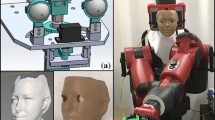Abstract
Recently, many control methods for autonomous robots based on biological mechanisms have been studied. In particular, the concept of time to contact, called the tau-margin, which is studied in ecological psychology, has attracted considerable attention. In conventional studies, various approaches have been used for the determination of the tau-margin, and the tau-margin has been used for the timing control of mobile robots. However, in these studies, robots fitted with a light bulb have been used, and direct light from the bulb has been used to determine the tau-margin. It is impossible to apply conventional methods to robots that use indirect light for determining the tau-margin. Therefore, we have developed a compound eye sensor comprising photodiodes. We employ the framework of optical flow to detect objects, and determine the tau-margin from the apparent size of the detected objects and the temporal changes in size. To demonstrate the effectiveness of the developed compound eye sensor, we control a mobile robot using this sensor, and conduct experiments in which the robot has to avoid an oncoming object. The timing of the robot is controlled by using the tau-margin. We conducted experiments by using an actual robot, and found that the robot could avoid an oncoming object successfully. We concluded that it is possible to determine the tau-margin by using the compound eye sensor which we have developed.
Similar content being viewed by others
Explore related subjects
Discover the latest articles, news and stories from top researchers in related subjects.References
Hoshino K (2005) Visual system inspired by the insect compound eye (in Japanese). J Robotics Soc Jpn 23:32–35
Hoshino K, Mura F, Shimoyama I (2001) Fabrication and performance of compound eye sensors with scanning receptor arrays (in Japanese). J Robotics Soc Jpn 19:408–414
Sekine M, Umeda K (2001) Construction of compound-eye-type micro vision sensor with simple structure (in Japanese). J Horol Inst Jpn 45(2):54–62
Hoshino K, Mura F, Shimoyama I (2001) A one-chip scanning retina with an integrated micromechanical scanning actuator. J Microelectromech Syst 10:492–497
Lee DN, Young DS (1985) Visual timing of interceptive action. In: Brain mechanisms in spatial vision, Kluwer, pp 1–30
Kai T, Shimada Y, Ito K (2007) Timing control of the mobile robot using tau-margin. Proceedings of the 13th International Symposium on Artificial Life and Robotics, pp 907–910
Fuse T, Shimizu E, Tsutsumi M (2000) A comparative study on gradient-based approaches for optical flow estimation (in Japanese). Proc Appl Survey Technol 11:45–52
Horn BKP, Schunk BG (1981) Determining optical flow. Artif Intell 17:185–203
Author information
Authors and Affiliations
Corresponding author
Additional information
This work was presented in part at the 14th International Symposium on Artificial Life and Robotics, Oita, Japan, February 5–7, 2009
About this article
Cite this article
Kaneta, Y., Katsuyama, Y. & Ito, K. Determination of time to contact using a compound eye sensor. Artif Life Robotics 14, 279–283 (2009). https://doi.org/10.1007/s10015-009-0673-2
Received:
Accepted:
Published:
Issue Date:
DOI: https://doi.org/10.1007/s10015-009-0673-2




